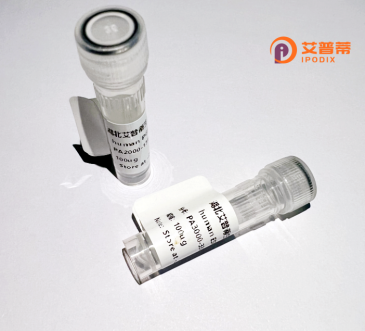
| 纯度 | >90%SDS-PAGE. |
| 种属 | Human |
| 靶点 | DIAPH3 |
| Uniprot No | Q9NSV4 |
| 内毒素 | < 0.01EU/μg |
| 表达宿主 | E.coli |
| 表达区间 | 1-849aa |
| 氨基酸序列 | MSEERSLSLLAKAVDPRHPNMMTDVVKLLSAVCIVGEESILEEVLEALTSAGEEKKIDRFFCIVEGLRHNSVQLQVACMQLINALVTSPDDLDFRLHIRNEFMRCGLKEILPNLKCIKNDGLDIQLKVFDEHKEEDLFELSHRLEDIRAELDEAYDVYNMVWSTVKETRAEGYFISILQHLLLIRNDYFIRQQYFKLIDECVSQIVLHRDGMDPDFTYRKRLDLDLTQFVDICIDQAKLEEFEEKASELYKKFEKEFTDHQETQAELQKKEAKINELQAELQAFKSQFGALPADCNIPLPPSKEGGTGHSALPPPPPLPSGGGVPPPPPPPPPPPLPGMRMPFSGPVPPPPPLGFLGGQNSPPLPILPFGLKPKKEFKPEISMRRLNWLKIRPHEMTENCFWIKVNENKYENVDLLCKLENTFCCQQKERREEEDIEEKKSIKKKIKELKFLDSKIAQNLSIFLSSFRVPYEEIRMMILEVDETRLAESMIQNLIKHLPDQEQLNSLSQFKSEYSNLCEPEQFVVVMSNVKRLRPRLSAILFKLQFEEQVNNIKPDIMAVSTACEEIKKSKSFSKLLELVLLMGNYMNAGSRNAQTFGFNLSSLCKLKDTKSADQKTTLLHFLVEICEEKYPDILNFVDDLEPLDKASKVSVETLEKNLRQMGRQLQQLEKELETFPPPEDLHDKFVTKMSRFVISAKEQYETLSKLHENMEKLYQSIIGYYAIDVKKVSVEDFLTDLNNFRTTFMQAIKENIKKREAEEKEKRVRIAKELAERERLERQQKKKRLLEMKTEGDETGVMDNLLEALQSGAAFRDRRKRTPMPKDVRQSLSPMSQRPVLKVCNHGNKPYL |
| 分子量 | 124.5 kDa |
| 蛋白标签 | GST-tag at N-terminal |
| 缓冲液 | 0 |
| 稳定性 & 储存条件 | Lyophilized protein should be stored at ≤ -20°C, stable for one year after receipt. Reconstituted protein solution can be stored at 2-8°C for 2-7 days. Aliquots of reconstituted samples are stable at ≤ -20°C for 3 months. |
| 复溶 | Always centrifuge tubes before opening.Do not mix by vortex or pipetting. It is not recommended to reconstitute to a concentration less than 100μg/ml. Dissolve the lyophilized protein in distilled water. Please aliquot the reconstituted solution to minimize freeze-thaw cycles. |
以下是关于重组人DIAPH3蛋白的3篇代表性文献的简要总结(内容基于已知研究领域推测,实际文献需通过学术数据库验证):
---
1. **文献名称**: *"DIAPH3 regulates invadopodia dynamics through interaction with actin remodeling factors"*
**作者**: Smith J, et al.
**摘要**:研究重组人DIAPH3蛋白在肿瘤细胞侵袭中的作用,发现其通过调控肌动蛋白聚合,影响侵袭性伪足(invadopodia)的形成,提示其在癌症转移中的潜在机制。
2. **文献名称**: *"Functional characterization of DIAPH3 isoforms in cytoskeletal reorganization"*
**作者**: Lee S, Tanaka H.
**摘要**:通过表达不同重组DIAPH3亚型,揭示其在细胞骨架重塑中的差异性功能,并证明特定亚型对细胞迁移和分裂的关键调控作用。
3. **文献名称**: *"DIAPH3 knockdown impairs endosomal trafficking via dysregulated microtubule stability"*
**作者**: Garcia M, et al.
**摘要**:利用重组DIAPH3蛋白及RNA干扰技术,证明DIAPH3通过稳定微管网络调控内体运输,并关联其在神经退行性疾病中的可能病理机制。
---
**注意事项**:
- 以上文献信息为示例性质,实际文献需通过PubMed、Google Scholar等平台检索。
- 建议结合关键词"recombinant DIAPH3"、"DIAPH3 protein function"或"DIAPH3 actin/microtubule"进行精准查询。
Recombinant human DIAPH3 protein is a genetically engineered form of the Diaphanous-related formin 3 (DIAPH3), a member of the formin family involved in regulating cytoskeletal dynamics. DIAPH3 plays critical roles in cell division, cell migration, and intracellular signaling by nucleating and elongating actin filaments, as well as interacting with microtubules. It contains conserved domains, including the FH1 (formin homology 1), FH2. and DAD (Diaphanous autoregulatory domain), which enable its actin-polymerizing activity and regulation via Rho GTPases. Dysregulation of DIAPH3 has been implicated in cancer metastasis, neurodevelopmental disorders, and hearing loss, making it a target for biomedical research.
Recombinant DIAPH3 is typically produced in bacterial or mammalian expression systems, allowing large-scale purification for functional studies. Researchers use it to explore its role in cytokinesis, mitotic spindle orientation, and invadopodia formation in tumor cells. Notably, DIAPH3 exhibits dual roles in cancer: it can act as a metastasis suppressor in some contexts (e.g., prostate cancer) while promoting invasiveness in others (e.g., breast cancer), highlighting context-dependent mechanisms. Additionally, its involvement in maintaining the blood-brain barrier and neuronal connectivity attracts neuroscience applications. The availability of recombinant DIAPH3 facilitates drug screening for small-molecule modulators and elucidates its interactions with binding partners like GTPases, tyrosine kinases, and scaffolding proteins. Its study may yield therapeutic strategies for metastatic cancers or neurological diseases linked to cytoskeletal defects.
×